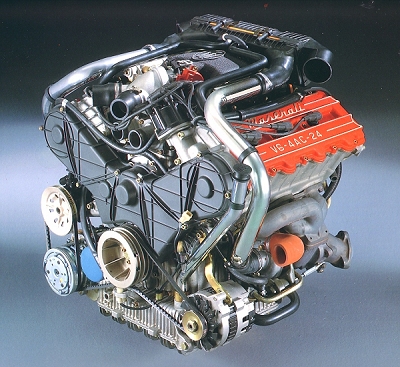 The V6 - 4ohc - 24v Engine
The V6 - 4ohc - 24v Engine
The Body
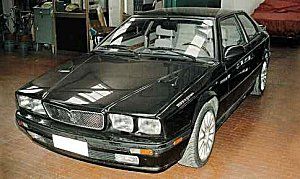
Produced from 1988 to 1992 the new 2.24v. differed little from its predecessor and still sported the traditional four rectangular
headlamps but with a more sporty looking radiator grille. Side skirts were added and a new front spoiler
with two fog lights set either side of central air vent improved the drag coefficiency. This spoiler now included air ducts
for the twin intercoolers now mounted just behind the headlamps. The bonnet included air vents.
Four exhaust pipes now exited neatly from ducts in the re-designed rear bumper. A rear spoiler was added to the boot lid
to give better handling at top speed.
The Engine
The real changes however were under the bonnet with the twin overhead camshaft, eighteen
valve engine being replaced by a more powerful four overhead camshaft twenty four valve engine.
Engine capacity remained the same with the 'Casa' favouring the 2-litre block. This new engine developed 245 bhp at 6,200 rpm
and propelled the car to 100 km/h in only 5,9 seconds and gave a top speed of over 230 km/h, yet allowed the
car to behave properly when driven in town traffic.
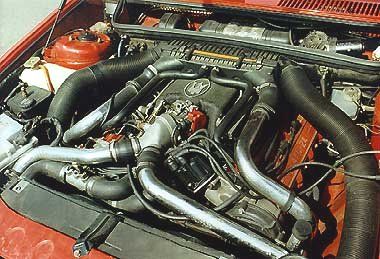 The new 2.24v.
The new 2.24v.
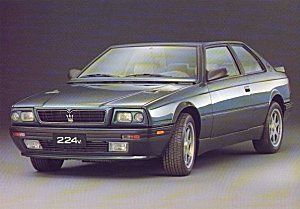
The latest series of the 2.24v.
was given a subtle facelift with some of the sharp angles smoothed out and the new lower radiator grille
gave the new look 2.24v. a more aggressive look. These changes not only improved its
looks but also its drag-coefficiency. The dipped beam headlamps were the smaller, circular polyelliptical type
and giving better visibility at high speed. The headlamps were rectangular in shape and fitted with halogen bulbs.
Under the front bumper two foglamps were encased in the restyled front spoiler giving a much smoother line.
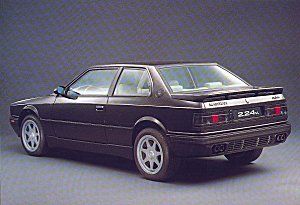
Set into the bonnet were two new air vents to aid airflow through the engine bay. A new spoiler mounted just in front of
the windscreen not only aided the aerodynamics but increased windscreen wiper efficiency.
It also helped hide the wipers giving a cleaner look. New side skirts and a rear spoiler mounted on the boot lid added to the aerodynamics and new elegantly styled
seven spoke 16 inch wheels gave the car an aggresive, sporty look. A new range of colours was also added to the range.
The Interior
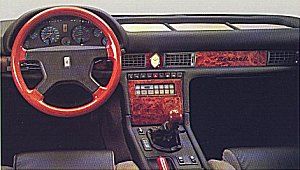
The interior of the latest series of the 2.24v.
emphasises the style and tradition of Maserati: the re-designed seats were in leather with side panels finished in
Alcantara. The quality of the elm wood had been enriched, giving the interior an even richer feel:
with the gear knob, the handbrake lever, the dashboard trim, the door trim and the climate control panel all finished in elm;
the spokes of the wood-rimmed steering wheel, with its centre in leather, now housed horn buttons.
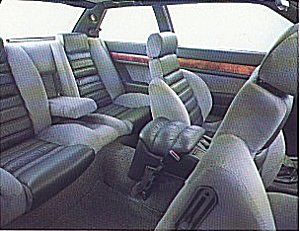 The 2.24v. was equipped with climate control which allowed the driver to experience a pre-selected
temperature, this temperature was assured through twelve controllable outlets. The new front seats, after extensive ergonomic
research, gave excellent lateral support and reclined electrically. To facilitate entry to the rear seats'
the seat when tilted forward automatically moved forwards. The now classic dashboard had some minor
design improvements and of course the clock still adorned the centre. Standard equipment included
a fully adjustable steering wheel, touch sensitive climate control, central locking and electrically adjustable driver's seat,
electric exterior rear view mirrors and windows.
The 2.24v. was equipped with climate control which allowed the driver to experience a pre-selected
temperature, this temperature was assured through twelve controllable outlets. The new front seats, after extensive ergonomic
research, gave excellent lateral support and reclined electrically. To facilitate entry to the rear seats'
the seat when tilted forward automatically moved forwards. The now classic dashboard had some minor
design improvements and of course the clock still adorned the centre. Standard equipment included
a fully adjustable steering wheel, touch sensitive climate control, central locking and electrically adjustable driver's seat,
electric exterior rear view mirrors and windows.
Suspension and Braking System
Independent on all four wheels,
Maserati now offered, as an optional extra, a system of electronically controlled adjustable
suspension developed in co-operation with Koni. The driver was able to change the damper setting
from a switch on the centre console. The four settings allowed the driver to adjust the setting
from soft to firm according to road conditions. The system became standard equipment on the later
version. This system proved so successful that it was used in the Shamal and the Ghibli II.
The front suspension was Mac Pherson type with anti-roll bar, coil-springs and dual-effect telescopic
pressurised shock absorbers. Rear suspension semi-trailing arms mounted on a subframe with coil-springs
and dual-effect telescopic shock absorbers. Steering was by rack and pinion. The power assisted twin
circuit braking system had disc brakes all round with ventillated discs, with floating calipers
at the front.
|
TECHNICAL DATA |
|
|
|
|
ENGINE |
|
|
Position |
front |
|
Cylinders |
No. 6V at 90º |
|
Bore and stroke |
82mm X 63mm |
|
Cubic capacity |
1996cc |
|
Compression ratio |
7.6 ± 0.4 |
|
Maximum torque with cat. |
34kgm/246lb-ft @ 3000rpm |
|
Maximum torque without cat. |
30.8kgm/223lb-ft @ 5000rpm |
|
Maximum power with cat. |
177kW/240bhp @ 6000rpm |
|
Maximum power without cat. |
180kW/245bhp @ 6200rpm |
Turbochargers |
No 2 IHI watercooled |
|
Intercoolers |
No 2 air to air |
|
|
|
|
ENGINE BLOCK and cylinder heads in light alloy with removable wet liners in Nigusil® treated aluminium. |
|
Water cooling by centrifugal pump. |
|
Forced lubrication with total filtering. |
|
No 4 overhead camshafts. |
|
No 24 valves, 4 valves per cylinder (2 intake, 2 exhaust). |
|
Electronic fuel injection and ignition. |
|
Permanent overboost / 105 amps alternator / leaded fuel. |
|
Catalytic emission control system with Lambda sonde. |
|
|
|
|
GEARBOX |
|
Getrag manual 5 speed + reverse / Rear wheel drive. |
|
|
|
|
DIFFERENTIAL |
|
Ranger® / Ratio: 3.77. |
|
|
|
|
CHASSIS |
|
Monocoque construction. |
|
|
|
|
SUSPENSION |
|
Independent on all 4 wheels with electronic adjustment on 4 settings. |
|
FRONT: Mac Pherson strut with antiroll bar, coil springs, oleodynamic pressurised bitubo shock absorbers, with double effect. |
|
REAR: Tubular trailing arms, coil springs, oleodynamic pressurised shock absorbers, stabilizer bars. |
|
|
|
|
STEERING: Power assisted rack and pinion steering. |
|
|
|
|
BRAKING SYSTEM |
|
Hydraulic, independent, power assisted twin circuit. |
|
Front and rear ventilated discs with floating calipers. |
|
Rear drum parking brakes. |
|
|
|
|
WHEEL RIMS |
|
Light Alloy- Front - 7"J X 16" Rear - 7"J X 16" |
|
|
|
|
TYRES |
|
Front - 205/50 ZR 16 Rear - 205/50 ZR 16 |
|
|
|
|
BODY |
|
2 door coupe, 5 seater, Sound proofed with Silent Travel®. Integral fog lights and rear mounted spoiler. |
|
|
|
|
PERFORMANCE |
|
|
Maximum speed with cat. |
over 140mph / 230kph |
|
Maximum speed without cat. |
over 140mph / 230kph |
|
Acceleration with cat. |
0-62mph 6.1secs |
|
Acceleration without cat. |
0-62mph 5.9secs |
|
Acceleration with cat. |
0-1000m 26.2secs |
|
Acceleration without cat. |
0-1000m 26.1secs |
|
|
|
|
DIMENSIONS AND WEIGHTS |
|
|
Wheelbase |
2514mm |
|
Front track |
1485mm |
|
Rear track |
1454mm |
|
Overall length |
4174mm |
|
Width |
1714mm |
|
Height |
1300mm |
|
Dry weight with cat. |
1305kg |
|
Dry weight without cat. |
1323kg |
|
Fuel tank |
80 litres |
|
Boot area |
400 cm³ approx |
|
Turning circle |
10.675m approx |
|
|
|
|

|
|
To enter Enrico's Maserati Pages CLICK HERE!
Copyright: Enrico's Maserati Pages - © 2000-2005. All rights reserved. |







 The 2.24v. was equipped with climate control which allowed the driver to experience a pre-selected
temperature, this temperature was assured through twelve controllable outlets. The new front seats, after extensive ergonomic
research, gave excellent lateral support and reclined electrically. To facilitate entry to the rear seats'
the seat when tilted forward automatically moved forwards. The now classic dashboard had some minor
design improvements and of course the clock still adorned the centre. Standard equipment included
a fully adjustable steering wheel, touch sensitive climate control, central locking and electrically adjustable driver's seat,
electric exterior rear view mirrors and windows.
The 2.24v. was equipped with climate control which allowed the driver to experience a pre-selected
temperature, this temperature was assured through twelve controllable outlets. The new front seats, after extensive ergonomic
research, gave excellent lateral support and reclined electrically. To facilitate entry to the rear seats'
the seat when tilted forward automatically moved forwards. The now classic dashboard had some minor
design improvements and of course the clock still adorned the centre. Standard equipment included
a fully adjustable steering wheel, touch sensitive climate control, central locking and electrically adjustable driver's seat,
electric exterior rear view mirrors and windows.